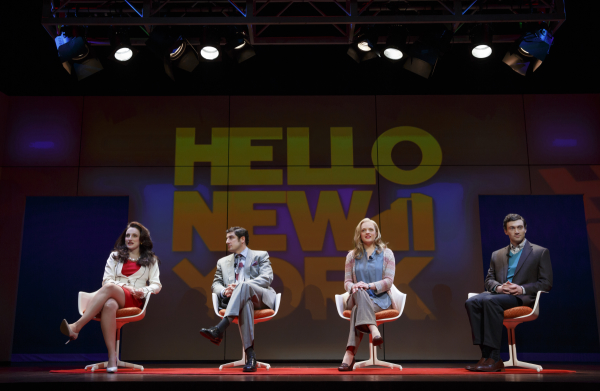The Heidi Chronicles

(© Joan Marcus)
Twenty-six years ago, Heidi Holland — the centerpiece of Wendy Wasserstein's Tony- and Pulitzer Prize-winning The Heidi Chronicles — made a wish for the succeeding generation of women. She wished for things to be "a little better" than they were for her as she fought alongside her fellow baby boomers to "have it all." Looking around at the now-grown-up population of millennials she was referring to, most of whom continue to fight the very same battles, we may find that there hasn't been as much progress as Wasserstein had originally anticipated. But if anything good came of this discouragingly slow societal transformation, it's that the women for whom Heidi threw down her feminist gauntlet nearly three decades ago can rediscover her as a peer in the inspired Broadway revival at the Music Box Theatre.
Elisabeth Moss, who made her mark as the barrier-breaking Peggy Olson on television's Mad Men, takes on the role of another empowered female of the 1960s. As Wasserstein's arguably most iconic character, Heidi has become a symbol of the women who pioneered gender parity five decades ago. In order to fend off the dreaded stamp of "dated," she must now represent today's career woman, while also maintaining the unique character with which Wasserstein initially imbued her. Moss treads these delicate waters admirably, injecting Heidi with the strength that keeps her traveling down the often lonely path she has chosen to pursue while shadowing her with a self-conscious timidity that nags at her like reins on a chariot.
As will forever be the case, career, marriage, and children make up the elusive trifecta for Wasserstein's title character, though in the 1960s, where her chronicles begin, few women even attempted the hat trick (perhaps the only substantial cultural divide between now and then). Consequently, Heidi is left in uncharted territory as an aspiring art historian whose career goals seem to preclude wedding bells and strollers. No character makes this clearer than Heidi's on-again-off-again lover Scoop Rosenbaum — an arrogant Princeton dropout who obnoxiously charms his way into Heidi's life at a Gene McCarthy dance in 1968. Jason Biggs officially retires the scrawny Jim Levenstein of American Pie as his commanding presence transforms him into that man you hate yourself for loving. He even maintains traces of likability as he pragmatically explains why he and Heidi, with equal career aspirations, could never marry: "Then you'd be competing with me," he says. It's an infuriating statement, but a sentiment that is sadly far from outmoded.
Tony-winning director Pam MacKinnon does not shy away from the original time period in her staging of the play. Wasserstein filled the script with era-specific references that take us from Heidi's awkward 1965 high school dance where she and her flirtatious friend Susan (a perfectly overstated Ali Ahn) sing along to "The Shoop Shoop Song" — to a 1970 women's liberation meeting that ends in a joyful Aretha Franklin "Respect" dance party — to a 1980 baby shower where a mournful "Imagine" spins on the record player in the wake of John Lennon's assassination. Leighton Bryan, Elise Kibler, and the particularly brilliant Tracee Chimo, who make up the rest of the female company, spout Wasserstein's incomparably witty dialogue via a variety different characters as they mark the passage of time in each of these group scenes.
Yet the overwhelming sense is that we are looking at images of different time periods rather than existing in them ourselves. Projections (by Peter Nigrini) of timely headlines and news reports surround the stage, while more literal environments (sharply designed by John Lee Beatty) are compressed to the center. Jessica Pabst's costumes similarly venture just beyond authenticity with archetypal outfits painting a paradigmatic picture of each decade (from patchy bell bottoms in the '60s to cinched power suits of the '80s).
The aesthetic removes us from the action when we would much prefer to be in the thick of it. However, it's a worthy sacrifice that allows for an efficient line to be drawn from the play to its modern audience. While the story being told is a retrospective, its recurring home base of a 1989 lecture hall where Heidi delivers a presentation about 16th-century female artists is no longer the "present day" it was when the play was first produced. Despite this, Wasserstein's still-relevant words do the work of bridging the time gap. As Moss delivers her heartbreaking second-act speech at the "Women, Where Are We Going" luncheon, you realize how many questions on this very subject remain unanswered.
The intimate relationships that MacKinnon's actors develop onstage compensate for any of the atmosphere's isolating effects. Moss develops an indelible chemistry with her other male costar, Bryce Pinkham, who plays her gay best friend Peter Patrone. Pinkham, the former Tony-nominated star of the musical A Gentleman's Guide to Love and Murder, blends his perfect comic timing with one of the finest dramatic performances of the season. He and Heidi weather the decades together like a tragic pair of soul mates, destined for a lifelong platonic romance.
Together, Heidi and Peter undergo subtle, yet ultimately overwhelming transformations from unsettled teens to evolved adults. They triumphantly sink into the lives they have carved out for themselves — each unorthodox and trailblazing in its own way. Though their paths have been walked by more since their first Broadway appearance, they are no less choppy or ridden with painful ambiguities than I imagine they were 26 years ago. But if you still leave the theater finding their respective stories unremarkable, you have Wendy Wasserstein to thank.










